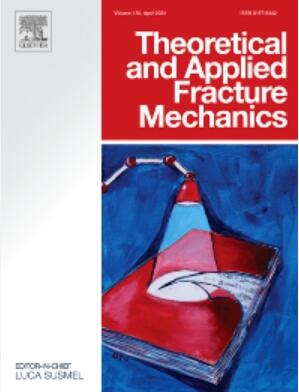A new prediction model of fatigue crack expansion rate based on HRR stress–strain field
IF 5
2区 工程技术
Q1 ENGINEERING, MECHANICAL
引用次数: 0
Abstract
In this paper, a new model (Cumulative Fatigue Damage-CFD) is constructed to accurately predict the expansion rate of type I fatigue cracks based on the damage accumulation theory. Utilizing the HRR (Hutchinson-Rice-Rosengren) stress–strain field at the crack tip, the model adopts a new size parameter rc to characterize the size of the cyclic plastic zone at the crack tip, defines a new damage variable D, and derives the theoretical formula of the fatigue crack extension rate model by combining with Miner’s linear cumulative damage theory. The prediction effect of the model was verified using 14 metallic materials and compared with the Pandey (Strain Energy Theory-SET), Chen-Cai (CFD) and LiuX (SET) models. To quantitatively and accurately evaluate the predictive efficacy of the model, a quantitative evaluation method called “point-line distance” is proposed, and a comprehensive comparison is made in terms of three key dimensions: safety, accuracy and economy. The results show that the new model (CFD) can accurately predict the expansion rate of type I fatigue cracks, and the model applies to a wide range of metallic materials and has excellent prediction results, which can better meet the engineering needs for safety and economy.
求助全文
约1分钟内获得全文
求助全文
来源期刊

Theoretical and Applied Fracture Mechanics
工程技术-工程:机械
CiteScore
8.40
自引率
18.90%
发文量
435
审稿时长
37 days
期刊介绍:
Theoretical and Applied Fracture Mechanics'' aims & scopes have been re-designed to cover both the theoretical, applied, and numerical aspects associated with those cracking related phenomena taking place, at a micro-, meso-, and macroscopic level, in materials/components/structures of any kind.
The journal aims to cover the cracking/mechanical behaviour of materials/components/structures in those situations involving both time-independent and time-dependent system of external forces/moments (such as, for instance, quasi-static, impulsive, impact, blasting, creep, contact, and fatigue loading). Since, under the above circumstances, the mechanical behaviour of cracked materials/components/structures is also affected by the environmental conditions, the journal would consider also those theoretical/experimental research works investigating the effect of external variables such as, for instance, the effect of corrosive environments as well as of high/low-temperature.
 求助内容:
求助内容: 应助结果提醒方式:
应助结果提醒方式:


